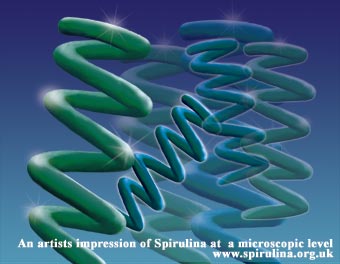Spirulina is a microscopic blue-green algae that exists as a single celled organism that turns sunlight into life energy.
It is one of the first life forms designed by nature, more than 3.6 billion years ago. Spirulina contains billions of years of evolutionary wisdom in its DNA and is an offspring of earth’s first photosynthetic life forms.
Under a microscope, Spirulina is a blue-green color and has the appearance of a spiral of long thin threads.
Spirulina is exceedingly adaptable and occurs in a wide variety of environments, including fresh water, tropical springs, saltwater and saltpans.
Spirulina is full of nutrients and very easily digested. Commercially, Spirulina is available as a powder, tablet and capsule or already added to some foods and health tonics.
There are many forms of valuable algae, and in the last 40 years Spirulina has been singled out for its nutritional properties. Long before it became a favorite of the health food industry (centuries ago), Spirulina was eaten regularly by North Africans and Mexicans. Now many people around the globe realize that Spirulina is a powerful food, with huge potential as a whole food source, as well as being a medicine and biochemical resource.
A great deal of research has concentrated on the cultivation and harvesting of what is affectionately referred to as ‘the green’. It has been described as ‘probiotic’ and a ‘superfood’.
The cultivation of Spirulina has also brought interest because, as with most micro algae, Spirulina is extremely adaptable, often thriving in extreme conditions. With its rich nutritional goodness and ability to grow in adverse conditions, Spirulina has a huge potential to be a food source that will help feed and nourish the worlds population.
As a plant, Spirulina is incredibly rich, containing a balance of nutrients that make it virtually a ‘whole food’ – capable of sustaining life without the need for other foods.
Spirulina provides vitamins, many minerals, essential amino acids, carbohydrates and enzymes. Spirulina is at least 60% vegetable protein, which is predigested by the algae, making it a highly digestible food. It is higher in protein than any other food. Its outstanding nutritional profile also includes the essential fatty acids, GLA fatty acid, lipids, the nucleic acids (RNA and DNA), B complex, vitamin C and E and phytochemicals, such as carotenoids, chlorophyll (blood purifier), and phycocyanin (a blue pigment), which is a protein that is known to inhibit cancer.
A breakdown in nutritional terms of a few of the most commonly available supplements reveals an impressive comparison.
How is it grown?
Spirulina thrives in natural alkaline lakes. Spirulina farming is part of the new era of ecological agriculture. The key component in the production of Spirulina is sunlight, and attention is given to measurement of temperature and oxygen levels.
Because pesticides and herbicides would kill many important microscopic life forms in a pond, algae scientists have learned how to balance pond ecology without the use of these harmful substances.
This form of aquaculture represents one of the solutions needed to produce food, while restoring the planet.




